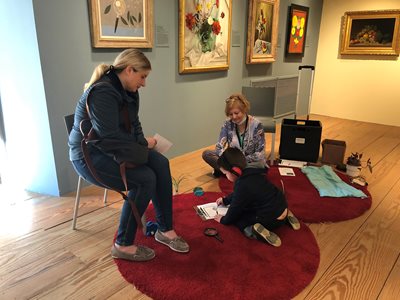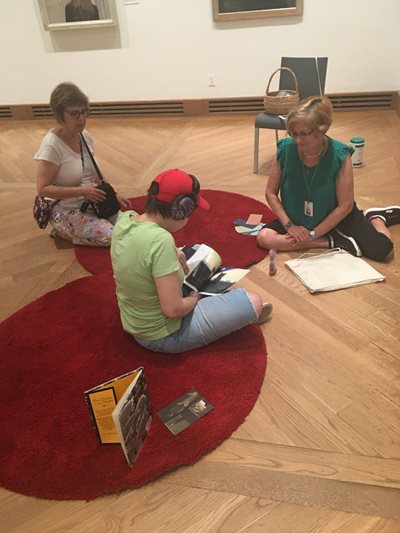When the Occupational Therapy (OT) Department at Salus University was in its infancy, it became known for helping create programs for museums to become more accessible to the disability community.
 Fern Silverman, EdD, OTR/L, associate professor of OT and assistant director of the Doctor of Occupational Therapy (OTD) program along with fellow OT faculty member, associate professor Andrea Tyszka, OTD, MS, OTR/L, SIPT, worked with The Franklin Institute on sensory support and presented at conferences that earned them the reputation of being consultants in working with museums.
Fern Silverman, EdD, OTR/L, associate professor of OT and assistant director of the Doctor of Occupational Therapy (OTD) program along with fellow OT faculty member, associate professor Andrea Tyszka, OTD, MS, OTR/L, SIPT, worked with The Franklin Institute on sensory support and presented at conferences that earned them the reputation of being consultants in working with museums.
It was that foundation and reputation that led to a partnership, now five years in the making, between Salus University and Brandywine River Museum of Art in Chadds Ford, Pennsylvania, to create accessible programming for visitors with autism and sensory-processing disorders.
Over the course of the past five years, the project has blossomed into an interdisciplinary collaboration that not only includes the OT department, but the University’s Speech-Language Pathology (SLP) and Blindness and Low Vision Studies (BLVS) departments as well.
"I think it’s probably one of the first unique partnerships where it kind of grew organically, from department to department,” said Tyszka. “And, now we have three different professions represented at one local museum that are working on accessibility initiatives.” This is truly inter professional education at work in the field.
 The Brandywine River Museum of Art has long been committed to providing opportunities for families in the community to engage with its art collection. However, its successful efforts to expand programs to reach broad family audiences has resulted in large attendance numbers which can create an environment that is challenging to visitors with sensitivities to noise and crowds.
The Brandywine River Museum of Art has long been committed to providing opportunities for families in the community to engage with its art collection. However, its successful efforts to expand programs to reach broad family audiences has resulted in large attendance numbers which can create an environment that is challenging to visitors with sensitivities to noise and crowds.
“By working with representatives from the neuro-diverse community and forming an advisory committee, the museum learned that in this case it was less helpful to focus on making our existing events more inclusive and more effective to create special opportunities for relaxed and adapted experiences,” said Laura Westmoreland, former associate educator of adult and community programs at the museum. “Without opportunities like these, some members of the community may not be able to access the collection and programs that the Brandywine offers.”
One of the programs developed is called “Sensory-Friendly Saturdays,” which includes creating “hands-on” opportunities in the individual galleries so visitors can engage in artwork in ways other than just viewing and reading wall labels.
“For kids with learning disabilities, especially those with autism, that doesn’t make sense to them. They don’t engage just visually,” said Tyszka. “For example, there is a really famous river painting, and it had some texture to it. As a grown adult it took everything I had not to walk up and touch this painting. So Laura had re-created the painting into 3-D maps that the children could touch that were in front of the painting.”
The framework the students created for the first event in 2017 has been used with periodic updates over the past five years for all following programs. Salus University’s OT and SLP students volunteer their time and are stationed with museum docents at the adapted exhibits, ostensibly so they can be there to help bridge the gap and help interact with the children in a developmentally appropriate way, according to Tyszka.
“We realized that for kids on the autism spectrum, it’s not just sensory issues, but kids have trouble communicating,” she said. “So we thought it would be great to invite some of the SLP students out to help during these events.”
For Salus student Sara Herman ‘23SLP, the program gives her a chance to experience working with the autism population, helps her understand what activities work well and what behaviors of her own were appropriate when working with the children.
 “I found all the children to be so different in their expression and interests, it was really fun to see such a wide variety,” said Herman. “It's always important to remember that not everyone with sensory deficits present the same way, and I think each activity the Brandywine staff prepared did a really nice job catering to that fact.”
“I found all the children to be so different in their expression and interests, it was really fun to see such a wide variety,” said Herman. “It's always important to remember that not everyone with sensory deficits present the same way, and I think each activity the Brandywine staff prepared did a really nice job catering to that fact.”
In early 2022, Westmoreland met with faculty from the Salus BLVS department to share another Brandywine initiative, that of prototyping a digital guide intended to be accessible and useful for blind and low vision users.
The guide provides all of the text found in a gallery (wall panels and labels for individual works of art) in a digital format that can be used with screen readers as well as in recorded audio, plus extended visual descriptions of each work of art. Representatives from the BLVS program helped connect the museum with individuals who use screen reader to test the prototype and provide feedback about how to make it more accessible and valuable to visitors, she said.
Overall, the partnership between Salus University and Brandywine River Museum of Art has been a win-win.
“It’s been nice to watch it over the past five years grow slowly into what it has become — a true multidisciplinary collaboration,” said Tyszka.